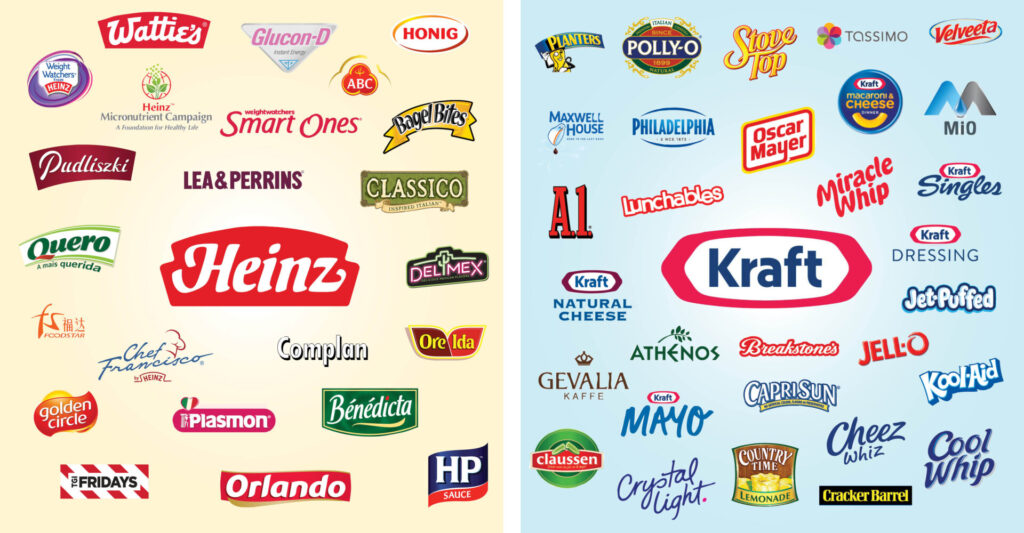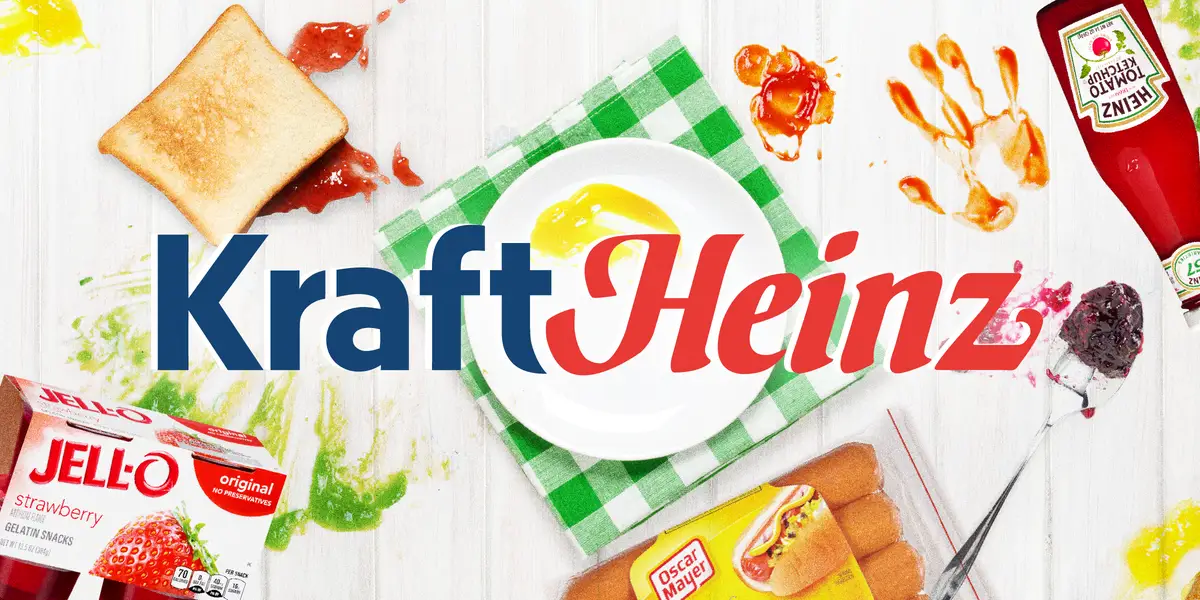The Kraft Heinz Company, commonly known as Kraft Heinz, is a global food and beverage giant born from the 2015 merger of two American powerhouses: Kraft Foods and H.J. Heinz Company. This historic union solidified Kraft Heinz’s position as one of the world’s leading producers of delicious and well-loved food products, making it the third-largest food and beverage company in North America and the fifth-largest globally.
With over $26 billion in annual sales and a presence in over 40 countries, Kraft Heinz boasts a diverse portfolio of iconic brands that grace dinner tables and grocery carts worldwide. From the creamy goodness of Velveeta cheese to the timeless taste of Heinz ketchup, Kraft Heinz products are synonymous with quality, convenience, and familiar flavors.
The roots of Kraft Heinz can be traced back to 1869, when James L. Kraft began selling cheese from a horse-drawn cart in Chicago. Meanwhile, across the country in Pittsburgh, Henry John Heinz established his now-famous ketchup company in 1869. Over the following century, both companies flourished, independently building strong brand identities and becoming household names in the United States.

In 2015, a historic merger brought these two titans together, creating the world’s fifth-largest food and beverage company. This strategic move combined Kraft’s expertise in cheese, processed foods, and beverages with Heinz’s strength in condiments and sauces. The merger not only expanded Kraft Heinz’s product portfolio but also solidified its position as a major player in the global food industry.
Kraft Heinz boasts a diverse and impressive brand portfolio, encompassing over 200 legacy and emerging brands. These brands span various food and beverage categories, offering consumers a wide range of options to suit their preferences and needs. Some of the company’s most recognizable brands include:
- Kraft: Macaroni and cheese, cheese, dressings
- Oscar Mayer: Lunchables, cold cuts, hot dogs
- Heinz: Ketchup, condiments, sauces
- Philadelphia: Cream cheese, dips, spreads
- Lunchables: Pre-packaged meals for children
- Velveeta: Cheese spreads

Beyond its established brands, Kraft Heinz is also committed to fostering innovation and venturing into new territories. The company actively seeks out emerging trends and consumer preferences, expanding its portfolio with acquisitions like Primal Kitchen, a brand focused on clean-label and organic ingredients, and launching new product lines that cater to evolving dietary needs and flavor profiles.
Kraft Heinz recognizes its responsibility as a global food leader and is committed to operating sustainably throughout its supply chain. The company focuses on responsible sourcing practices, minimizing its environmental footprint, and creating a positive social impact in the communities it operates within.
As Kraft Heinz navigates the ever-changing landscape of the food industry, it remains dedicated to its core values of quality, taste, and convenience. By leveraging its rich heritage, diverse brand portfolio, and commitment to innovation and sustainability, Kraft Heinz aims to continue delighting consumers around the world for generations to come.
Marketing Strategies of Kraft Heinz
Kraft Heinz isn’t just known for its iconic products – it’s also recognized for its strategic marketing approaches. By leveraging a combination of traditional and modern techniques, Kraft Heinz cultivates brand loyalty and drives sales across its vast portfolio. Let’s delve into some of their key marketing strategies:
1. Brand Portfolio
Kraft Heinz Company (KHC) boasts a diverse brand portfolio, including iconic names like Kraft, Heinz, Oscar Mayer, Philadelphia, and Jell-O. These brands are strategically organized into six consumer-focused platforms, each catering to specific needs and occasions. This structure allows KHC to effectively target various demographics and situations.
KHC leverages its brand portfolio as a core marketing strategy. The company capitalizes on the emotional connection consumers have with its brands, often linked to positive memories and experiences. This fosters brand loyalty and trust, giving KHC an edge over competitors.
Furthermore, KHC’s brands are renowned for their high quality, innovation, and unique flavors. The company continuously invests in new products and marketing initiatives to maintain brand freshness and relevance. This commitment to product development and brand promotion has significantly contributed to KHC’s success, solidifying its position as a leading player in the food and beverage industry.
2. Product Innovation
Kraft Heinz recognizes product innovation as a crucial marketing strategy. The company consistently introduces groundbreaking products, like Homebake, which utilizes technology to revolutionize family meals. Additionally, HEINZ REMIX showcases their innovative spirit, offering a customizable digital product with over 200 sauce combinations developed in a short time frame. These examples highlight KHC’s commitment to staying ahead of the curve by creating exciting and new-to-market products.
Beyond launching new products, KHC focuses on reformulating existing lines. This strategy emphasizes “positive nutrition”, addressing consumer demands for healthier options while maintaining brand favorites. This approach, alongside transforming its portfolio to align with evolving consumer preferences, demonstrates KHC’s dedication to adapting and evolving its product offerings to stay relevant in the market.
Furthermore, KHC is expanding its Go-to-Market Model to capitalize on fast-growing markets. This strategy ensures wider product accessibility and caters to new consumer segments, showcasing their focus on growth and adaptability in an ever-changing market landscape.
3. Partnerships and Collaborations
Kraft Heinz leverages partnerships and collaborations as a key marketing strategy to achieve various objectives. Partnering with established entities like AB InBev allows KHC to expand its reach in emerging markets by utilizing their e-commerce platform, BEES. This collaboration opens doors to new consumer segments and fosters brand growth.
Furthermore, KHC forms partnerships to address specific needs. The collaboration with Feeding America demonstrates their commitment to social responsibility through supporting their produce procurement programs. Similarly, the partnership with Genpact focuses on optimizing their supply chain, while the collaboration with Microsoft tackles supply chain innovation through digital advancements.
Beyond addressing specific needs, KHC engages in partnerships to enhance brand image and explore new possibilities. The collaboration with Wyss Institute for product development showcases their commitment to innovation, while working with Snowflake facilitates deeper collaboration with retail partners, strengthening their distribution network. Additionally, partnering with celebrities like Ed Sheeran for the Taste Elevation platform leverages celebrity influence to connect with consumers and promote their products. By fostering diverse partnerships and collaborations, Kraft Heinz effectively addresses various marketing objectives and positions itself for sustained success.
4. Sustainability Initiatives
Kraft Heinz recognizes sustainability initiatives as a valuable marketing strategy. Their commitment to environmental responsibility resonates with a growing segment of consumers who prioritize eco-conscious brands.
Packaging is a key area of focus. Kraft Heinz has set ambitious goals to achieve 100% recyclable, reusable, or compostable packaging globally by 2025 and further reduce virgin plastic usage by 20% by 2030. These initiatives demonstrate their dedication to minimizing environmental impact and align with consumer preferences for sustainable packaging solutions.
Beyond packaging, Kraft Heinz addresses other sustainability aspects. They aim to reduce water use intensity across their facilities, specifically focusing on high-risk watershed areas. Additionally, they strive to minimize waste sent to landfills. These efforts showcase their commitment to responsible resource management and contribute to a healthier planet, resonating with environmentally conscious consumers.
Kraft Heinz’s sustainable development strategy encompasses various initiatives beyond marketing. Their commitment extends to responsible sourcing, promoting healthy living, and supporting communities. This comprehensive approach positions them as a leader in sustainable practices within the food and beverage industry, further solidifying their brand image and attracting environmentally conscious consumers.
5. Digital Marketing
Digital marketing plays a crucial role in Kraft Heinz’s overall marketing strategy. The company invests heavily in this area, ranking among the top spenders in the CPG and food & beverage industries for digital advertising. In 2022, they further emphasized their commitment by announcing an increased focus on long-term digital growth.
Kraft Heinz leverages various digital channels to reach consumers. They actively engage on social media platforms like Facebook, Twitter, Instagram, and YouTube, showcasing products, sharing recipes, and fostering interaction with their audience. Additionally, they have revamped their digital channels, implementing a clear shift in creative and messaging to resonate better with their target audience.
Furthermore, Kraft Heinz recognizes the importance of data and partnerships in the digital landscape. They are collaborating with companies like Google, Lytics, and LiveRamp to consolidate their first-party data, enabling them to gain deeper customer insights and personalize their marketing efforts. Additionally, they partnered with SparkOptimus to boost digital sales across various channels and identify eCommerce enablers for international markets. By employing a multifaceted digital marketing strategy, Kraft Heinz aims to maximize reach, engagement, and sales in the ever-evolving digital world.
6. Promotions and Discounts
Kraft Heinz utilizes promotions and discounts as a strategic tool to increase sales and brand awareness across various consumer segments. They implement various tactics to achieve this goal:
- Bundling: Kraft Heinz strategically groups their products, like in the Art of The Burger campaign, where condiments and cheese are bundled with private label buns. This encourages purchase of multiple items and potentially introduces new products to consumers.
- Coupons and Flyers: Offering coupons through various channels like newspapers, websites, and custom flyers provides direct savings to consumers, incentivizing purchase and potentially attracting price-conscious shoppers.
- Widespread Advertising: Kraft Heinz leverages radio, television, and social media advertisements to showcase their products and promotions to a broad audience. This approach aims to capture consumer attention and drive brand recall.
- Cash-Back Programs: Utilizing cash-back programs on their website provides an additional layer of incentive for online purchases, potentially attracting tech-savvy consumers and promoting direct sales.
By employing a combination of these promotional strategies, Kraft Heinz caters to a diverse range of consumers, including those seeking the best value and those drawn to specific products or experiences. Their pricing strategy considers market conditions and consumer behavior, aiming to offer competitive prices while maintaining high-quality products. The success of these strategies in driving sales suggests that Kraft Heinz will likely continue to leverage promotions and discounts as a key element of their marketing efforts.
By implementing these comprehensive marketing strategies, Kraft Heinz continues to be a dominant force in the food and beverage industry. Their ability to adapt, innovate, and connect with consumers on a personal level positions them for continued success in the ever-evolving marketing landscape.
Marketing Mix of Kraft Heinz
Kraft Heinz has built its empire on a strategic marketing mix. The 4Ps – Product, Price, Place, and Promotion – form the foundation of their marketing strategy, ensuring their products reach the right consumers at the right price, through the right channels, and with enticing messaging. Let’s delve deeper into each element and explore how Kraft Heinz leverages them to achieve success.
1. Product
Diversity: Kraft Heinz boasts a vast and diverse product portfolio catering to a wide range of consumer needs and preferences. From iconic brands like Kraft Mac and Cheese and Heinz Ketchup to innovative offerings like Lunchables and Philadelphia Dips, they offer something for everyone. This diversity allows them to capture a larger market share and cater to various eating occasions.
Quality and Consistency: Consumers trust Kraft Heinz products for their consistent quality and familiar taste. The company prioritizes maintaining high standards for ingredients and manufacturing processes, ensuring their products deliver a satisfying experience every time.
New Product Development: While Kraft Heinz capitalizes on its legacy brands, they also understand the need for innovation. They continuously invest in research and development, introducing new products that cater to evolving consumer trends, such as organic options, gluten-free alternatives, and single-serve convenience meals.
Brand Positioning: Kraft Heinz strategically positions its brands to occupy distinct spaces within the market. For example, Kraft Mac and Cheese is known for its nostalgic comfort, while Velveeta focuses on creamy indulgence. This clear positioning helps consumers easily identify products that align with their needs and preferences.
2. Price
Value Pricing: Kraft Heinz understands that price is a significant factor for many consumers. They employ value-based pricing strategies, ensuring their products remain accessible to a broad range of income levels. This is particularly important for staple food items like condiments and boxed meals.
Price Promotions and Bundling: Kraft Heinz frequently utilizes promotional offers like coupons, discounts, and bundled packages to incentivize purchase and encourage trial of new products. This strategy not only attracts budget-conscious consumers but also allows them to test new offerings without significant risk.
Premiumization: For specific product lines, Kraft Heinz employs a premium pricing strategy. This is often seen with organic or specialty options that cater to health-conscious consumers or those seeking higher quality ingredients.
3. Place
Extensive Distribution Network: Kraft Heinz has established a robust distribution network that ensures their products are readily available in grocery stores, convenience stores, and mass retailers worldwide. This widespread availability makes it convenient for consumers to find their favorite Kraft Heinz products wherever they shop.
Direct-to-Consumer Options: While traditional distribution channels remain crucial, Kraft Heinz also explores direct-to-consumer options. This might involve online ordering platforms or partnerships with meal kit delivery services, offering increased accessibility and convenience for tech-savvy consumers.
Strategic Partnerships: Kraft Heinz forms strategic partnerships with restaurants, foodservice companies, and even theme parks to place their products in new environments. This expands their reach beyond traditional grocery stores and exposes them to a wider consumer base.
4. Promotion
Multi-Channel Marketing: Kraft Heinz utilizes a multi-channel marketing approach to reach consumers on various platforms. This includes television commercials, print advertising, social media marketing, influencer collaborations, and engaging content on their website. This comprehensive approach ensures maximum brand visibility and caters to diverse consumer preferences for content consumption.
Emotional Connection: Kraft Heinz’s marketing campaigns often go beyond just showcasing products. They strive to create an emotional connection with consumers by emphasizing the joy of cooking, sharing meals with loved ones, and creating family traditions. This emotional appeal fosters brand loyalty and makes their products more than just food; they become a part of consumers’ lives.
Targeted Messaging: In today’s digital age, Kraft Heinz leverages data and analytics to tailor their messaging to specific consumer segments. This ensures their promotions and recipes are relevant and appealing to individual preferences and dietary needs.
Building Brand Communities: Kraft Heinz actively cultivates brand communities on social media platforms. They encourage user-generated content, recipe sharing, and consumer interaction, fostering a sense of community and brand loyalty.
In conclusion, by skillfully orchestrating the 4Ps of marketing, Kraft Heinz has secured its position as a leader in the food and beverage industry. Their diverse product portfolio, value-driven pricing, extensive distribution network, and engaging marketing strategies ensure their products remain accessible, relevant, and a delicious staple in kitchens around the world.
Also Read: Product Portfolio and Marketing Strategies of Heinz
To read more content like this, subscribe to our newsletter
Go to the full page to view and submit the form.


